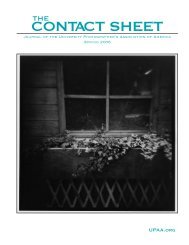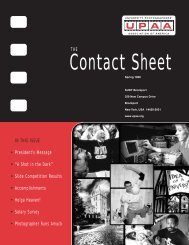Winter 2005 - University Photographers' Association of America
Winter 2005 - University Photographers' Association of America
Winter 2005 - University Photographers' Association of America
Create successful ePaper yourself
Turn your PDF publications into a flip-book with our unique Google optimized e-Paper software.
BITS & CHIPS<br />
A UPAA Technical Column<br />
by Dean Carothers <strong>of</strong> Tennessee Technological <strong>University</strong><br />
Piecing Together Digital Workflow<br />
Digital workflow is one <strong>of</strong> the<br />
favorite terms for consultants and<br />
$1,500-a-day seminar promoters.<br />
There are lots <strong>of</strong> s<strong>of</strong>tware packages<br />
that purport to improve our digital<br />
workflow, automate it or make it all<br />
easy and fast -- for a fee.<br />
For those <strong>of</strong> us that remember<br />
the days <strong>of</strong> labeling slide mounts<br />
and filing negatives and contact<br />
sheets digital workflow may sound<br />
more like hype and hucksterism<br />
than something that we need. While<br />
most <strong>of</strong> us can do without the fifty<br />
thousand dollar solutions there are<br />
some real issues and the way we<br />
choose to handle these issues now<br />
will have a major effect on how<br />
valuable our images will be in the<br />
future.<br />
I spoke with Dr. Patrick Reagan<br />
on my campus at Tennessee Tech<br />
about what historians think <strong>of</strong><br />
digital photography. I will skip his<br />
more succinct reply and tell you that<br />
he, and other historians worldwide,<br />
are shall we say, highly concerned.<br />
One aspect that I had not considered<br />
was that when we saved our<br />
negatives or slides we generally<br />
kept all, or at least most, <strong>of</strong> the<br />
images we made. Researchers <strong>of</strong>ten<br />
find that they can glean a lot <strong>of</strong><br />
information from the outtakes and<br />
duplicates. Think <strong>of</strong> Joseph Stalin's<br />
fondness for having anyone that he<br />
was on the outs with retouched out<br />
<strong>of</strong> <strong>of</strong>ficial photos. The historians are<br />
very concerned that only the final<br />
"corrected" images will be saved.<br />
While it sounds like all <strong>of</strong> us are<br />
taking the need to archive our<br />
images pretty seriously (that was a<br />
good session at the Symposium)<br />
there is still the issue <strong>of</strong> obsolescent<br />
storage systems. That is the <strong>of</strong>ficial<br />
way <strong>of</strong> saying "where do think you<br />
will have to go in twenty years to<br />
find a working CD drive?" If you<br />
are not worried about 20 years think<br />
about 100 years. That probably<br />
won't be our problem but it may be<br />
a big one for someone.<br />
All the variations <strong>of</strong> chemical<br />
based photography are still<br />
viewable with nothing more than a<br />
light source and our eyes. You don't<br />
see lantern slide projectors around<br />
much anymore but the images are<br />
still easily viewed. That means that<br />
it is very likely that the negatives<br />
from Aunt Sue's point and shoot<br />
may be more accessible in the future<br />
than the finely crafted photographs<br />
that we make with our Nikon D7x<br />
35MP pro cameras. Based on the<br />
discussion at the Symposium here<br />
are some things that I think we can<br />
all work on to make our work more<br />
accessible and useful.<br />
Metadata<br />
This is all the stuff that our<br />
digital cameras save with each<br />
photo in case we need to know that<br />
a photo was made a 1/160th <strong>of</strong> a<br />
second at f8.7 using a 24-85mm lens<br />
at 31.2mm focal length. That stuff<br />
really can be useful, but what we<br />
are really interested in is the IPTC<br />
data that we add to each image.<br />
IPTC data is a format proposed by<br />
the International Press<br />
Telecommunications Council to<br />
allow newspapers, magazines and<br />
wire services to send and receive<br />
data along with images that are<br />
transmitted electronically<br />
(www.iptc.org).<br />
Embedding the Who, What,<br />
Where, When data into each data<br />
file that we archive goes a long way<br />
toward making our photos more<br />
useful in the future. For some <strong>of</strong> us<br />
that future is not that far away<br />
either. S<strong>of</strong>tware like Canto Cumulus<br />
can index and allow searches on<br />
metadata. The last time I checked<br />
Cumulus only indexed some fields<br />
<strong>of</strong> the IPTC data and that feature<br />
was not on by default but it is there<br />
if you want it.<br />
Apple says that the next version<br />
<strong>of</strong> OS X will include metadata<br />
search as part <strong>of</strong> the operating<br />
system. If this proves to be<br />
implemented in a way that is useful<br />
to photographers it might be<br />
enough reason to keep paying the<br />
price for Apple computers all on it's<br />
own (www.apple.com/macosx/<br />
tiger/).<br />
Many s<strong>of</strong>tware packages let you<br />
edit and embed the metadata<br />
including Photoshop. Common<br />
packages like ACDSee:<br />
(www.acdsystems.com/English/<br />
Products/ACDSee/index.htm).<br />
F o t o s t a t i o n :<br />
(www.acdsystems.com/English/<br />
Products/ACDSee/index.htm and<br />
iView Mediapro). Www.iviewmultimedia.com<br />
make the job <strong>of</strong><br />
editing your shoot and embedding<br />
data easier. We really don't have<br />
much excuse for not captioning our<br />
photos with the best information<br />
that we have.<br />
Using standard descriptors<br />
wherever you can is another good<br />
idea. If I tag a photo as being made<br />
<strong>of</strong> the ‘admin bldg’ and you spell<br />
out the correct name,<br />
‘administration building,’ you<br />
won't ever find my photos using a<br />
search tool. Most schools have<br />
naming conventions for places and<br />
buildings. Likewise, tagging a<br />
photo as 'Dr Harrison' may be<br />
following protocol but a tag <strong>of</strong><br />
'Susan Harrison' or 'George<br />
Harrison' will avoid all sorts <strong>of</strong><br />
confusion later.<br />
What do we archive?<br />
'Best practices' say that our<br />
archive system should keep the<br />
original camera files as the main<br />
archival source. Do we delete the<br />
duds and the technical flaws? Like<br />
many <strong>of</strong> us, I do delete the truly<br />
awful shots but if we want to be a<br />
true archivist we should keep the<br />
whole shoot, duds and all. That<br />
doesn't mean that we have to show<br />
UPAA Contact Sheet 21




